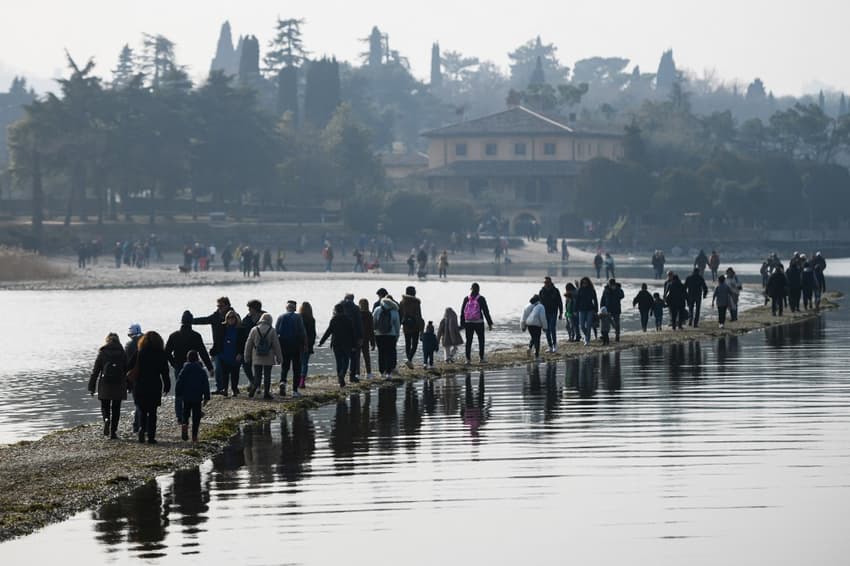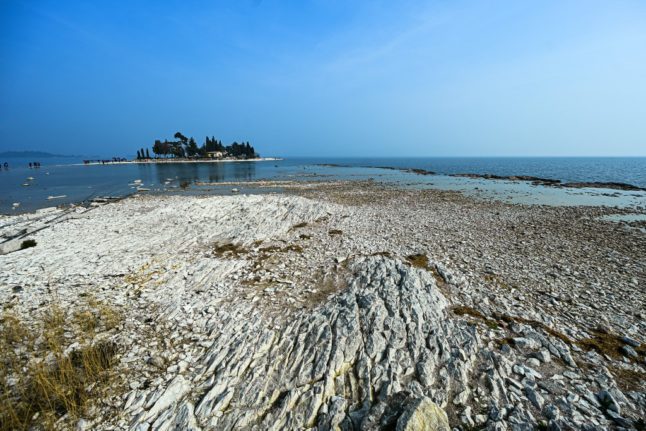Tourists flock to Lake Garda island made accessible by drought

Visitors have been using a newly resurfaced pathway to go from the edge of Lake Garda, Italy's largest lake, to the small island of San Biagio in what is a striking sign of the drought currently hitting the north of the country.
Dotted with cypresses and rocky white beaches, San Biagio island was in the past only accessible by boat.
But historically low waters on the lake have revealed a sand and stone causeway, and tourists are flocking to the site.
READ ALSO: Why Italy is braced for another major drought this spring
"It's a beautiful sight, but sad at the same time, because it's caused by drought. We hope it will be short-lived," said Alberto Pampuri, 62, who cycled to the spot with his wife and two friends from nearby Brescia.
The unusual phenomenon recalls the Floating Piers installation created in 2016 by artist Christo, when yellow floating footbridges were placed across nearby Lake Iseo.
"But they were artificial bridges, whereas this is a natural work of art," said Agata Carteri, a 48-year-old teacher.

An exceptionally dry winter has brought Lake Garda to its lowest wintertime water levels in over 30 years. Photo by Piero CRUCIATTI / AFP
A lack of snow on the surrounding mountains, warm temperatures and no rain for six weeks have combined to bring the water levels of Garda, Italy's largest lake, to its lowest winter level for 30 years.
READ ALSO: The three Italian regions hit hardest by the climate crisis
The waterline is 60 to 70 centimetres (around two feet) below the average for the last few decades.
Warning signs
After a record drought devastated local harvests last summer, the north of Italy is once again showing warning signs, with water levels low in the River Po, Lake Maggiore and Lake Como.
Five years ago, Matteo Fiori had to wade his way to San Biagio island, also known as the Island of Rabbits, holding his rucksack above his head to keep it dry.
"The water came up to my chest, it was an adventure," the 45-year-old social worker said as he surveyed the newly emerged causeway.
While the lack of snow spells trouble for ski resorts in the mountains, the novelty of the low waters is a boost for the little community of Manerba del Garda.
"The island has become a popular out-of-season attraction," said Mayor Flaviano Mattiotti.
"But if the level of the lake doesn't rise in the spring, we are ready to dredge the harbours to allow access for tourist boats, which would be a first."
READ ALSO: How climate change left Italy’s ski resorts fighting for survival

Some tourists are using bikes to reach the island of San Biagio. Photo by Piero CRUCIATTI / AFP
Almost 28 million tourists visited Lake Garda last year, around 40 percent of them from Austria, Germany and Switzerland.
"It's like walking on water," said Afra Vorhauser, from the northern town of Merano, after walking across to the uninhabited island.
In the bright February sun, families had picnics on the grass or at wooden tables, while children climbed rocks or skimmed stones on the exposed beaches.
This winter has seen a "new tourist movement, born out of the curiosity for discovering areas of the lake that are normally below water", said Paolo Artelio, head of local tourism agency Visitgarda.
These include the Grottoes of Catullus, the ruins of a Roman villa built on the Sirmione peninsula, a part of which has emerged thanks to the lower water level.
But officials are keen to emphasise that the normal attractions of the lake remain.
"For tourists, nothing changes, because the lake still has an average depth of 136 metres – they can surf, sail or swim as they wish," said Pierlucio Ceresa, secretary general of the Garda Community, which is responsible for the quality of the water.
He said it was "premature to proclaim a disaster", saying that if it snows in the coming weeks and rains in March, the situation "will return to normal".
By AFP's Brigitte Hagemann
Comments
See Also
Dotted with cypresses and rocky white beaches, San Biagio island was in the past only accessible by boat.
But historically low waters on the lake have revealed a sand and stone causeway, and tourists are flocking to the site.
READ ALSO: Why Italy is braced for another major drought this spring
"It's a beautiful sight, but sad at the same time, because it's caused by drought. We hope it will be short-lived," said Alberto Pampuri, 62, who cycled to the spot with his wife and two friends from nearby Brescia.
The unusual phenomenon recalls the Floating Piers installation created in 2016 by artist Christo, when yellow floating footbridges were placed across nearby Lake Iseo.
"But they were artificial bridges, whereas this is a natural work of art," said Agata Carteri, a 48-year-old teacher.

A lack of snow on the surrounding mountains, warm temperatures and no rain for six weeks have combined to bring the water levels of Garda, Italy's largest lake, to its lowest winter level for 30 years.
READ ALSO: The three Italian regions hit hardest by the climate crisis
The waterline is 60 to 70 centimetres (around two feet) below the average for the last few decades.
Warning signs
After a record drought devastated local harvests last summer, the north of Italy is once again showing warning signs, with water levels low in the River Po, Lake Maggiore and Lake Como.
Five years ago, Matteo Fiori had to wade his way to San Biagio island, also known as the Island of Rabbits, holding his rucksack above his head to keep it dry.
"The water came up to my chest, it was an adventure," the 45-year-old social worker said as he surveyed the newly emerged causeway.
While the lack of snow spells trouble for ski resorts in the mountains, the novelty of the low waters is a boost for the little community of Manerba del Garda.
"The island has become a popular out-of-season attraction," said Mayor Flaviano Mattiotti.
"But if the level of the lake doesn't rise in the spring, we are ready to dredge the harbours to allow access for tourist boats, which would be a first."
READ ALSO: How climate change left Italy’s ski resorts fighting for survival

Almost 28 million tourists visited Lake Garda last year, around 40 percent of them from Austria, Germany and Switzerland.
"It's like walking on water," said Afra Vorhauser, from the northern town of Merano, after walking across to the uninhabited island.
In the bright February sun, families had picnics on the grass or at wooden tables, while children climbed rocks or skimmed stones on the exposed beaches.
This winter has seen a "new tourist movement, born out of the curiosity for discovering areas of the lake that are normally below water", said Paolo Artelio, head of local tourism agency Visitgarda.
These include the Grottoes of Catullus, the ruins of a Roman villa built on the Sirmione peninsula, a part of which has emerged thanks to the lower water level.
But officials are keen to emphasise that the normal attractions of the lake remain.
"For tourists, nothing changes, because the lake still has an average depth of 136 metres – they can surf, sail or swim as they wish," said Pierlucio Ceresa, secretary general of the Garda Community, which is responsible for the quality of the water.
He said it was "premature to proclaim a disaster", saying that if it snows in the coming weeks and rains in March, the situation "will return to normal".
By AFP's Brigitte Hagemann
Join the conversation in our comments section below. Share your own views and experience and if you have a question or suggestion for our journalists then email us at [email protected].
Please keep comments civil, constructive and on topic – and make sure to read our terms of use before getting involved.
Please log in here to leave a comment.